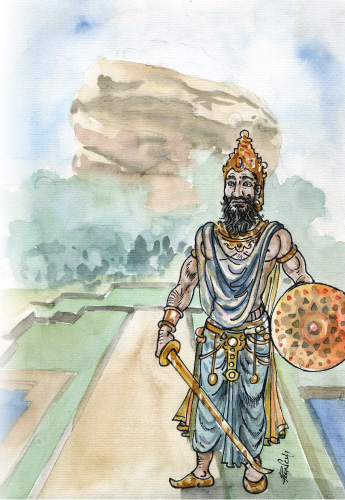King Kashyapa
by Husna Inayathullah
King Kashyapa's story is like a Shakespearean tragedy. He built the
most spectacular Sigiriya Rock Fortress in Sri Lanka 1,600 years ago. It
is a tale of cruelty,intrigue, patricide, vision, grandeur, chivalry,
betrayal and abandonment. Kashyapa ruled between 477 and 495 AD. He was
the second monarch of the Mauryan Dynasty of the Anuradhapura Kingdom.
He acquired the throne by overthrowing his father, King Dhatusena,
and usurping his brother and rightful heir to the throne, Moggallana, in
a palace coup. He imprisoned and later executed his father. Kashyapa was
also known as Pithru Ghathaka Kashyapa (Kashyapa the Patricide), after
this incident. He was later defeated by Moggallana who had fled to South
India and returned with an army to regain the throne.

Though Kashyapa was the eldest son of the king, he was not the heir
to the throne. Moggallana was the son of the royal consort and the
rightful heir to the throne, while Kashyapa was born to a non-royal
concubine. However, Kashyapa sought to acquire the throne by ousting
Moggallana. He was assisted by the Commander of the king's army, Migara,
who sought vengeance for a disagreement between himself and the king.
Assisted and encouraged by Migara, Kashyapa carried out a palace coup
and overthrew Dhatusena.
Dhatusena was imprisoned and Kashyapa became the king of the country
in 473 as the second king in the Mauryan Dynasty of Sri Lanka. However,
Moggallana fled to South India, fearing that his brother would
assassinate him. Migara led Kashyapa to believe that Dhatusena had a
treasure hidden away and Kashyapa demanded it from the imprisoned king.
Dhatusena took his captors to the Kalaweva, a large irrigation tank
he had constructed, and told him that it was the only treasure he had.
Enraged by this, Kasyapa had his father murdered by entombing him in a
wall.
Kashyapa incurred the wrath of the public and the Bhikkhus. He earned
the name Pithru Ghathaka Kashyapa which means Kashyapa the Patricide.
Due to this and fearing an attack from Moggallana, Kashyapa moved his
capital and residence from the traditional capital of Anuradhapura to
the more secure location of Sigiriya. At Sigiriya, he constructed a
large citadel and his palace was built on top of the Sigiriya Rock.
Sigiriya was a large rock rising above the surrounding plain offering
an unhindered view in all directions. It was chosen as the capital
because of the strategic advantage this would give the defenders during
an attack. Large ramparts and moats were built around the city. An
elaborate and large garden was built around the rock. The gardens
consisted a number of pools, fountains and other structures. A complex
underground irrigation system supplied water to the pools and fountains.
The fountains are functional to this day.
The constructions on top of the Sigiriya Rock include the king's
palace among several other buildings and pools. The Sigiriya frescoes
which depict maidens carrying flowers were also created during
Kashyapa's reign at Sigiriya.
Moggallana organised an army in South India and returned to Sri Lanka
to claim his right to the throne. In the battle that ensued in the
plains surrounding Sigiriya, Kashyapa's army was defeated. He killed
himself with his own sword. Kashyapa's reign as king of Sri Lanka ended
with the defeat in 495 and Moggallana became the king as Moggallana I. |

